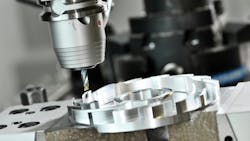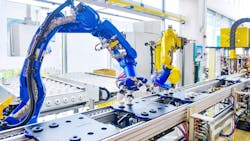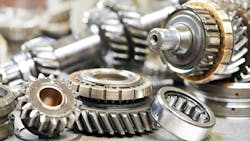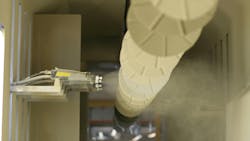How Surface Finishing Impacts the Accuracy and Reliability of Motion Control Systems
What you'll learn:
- The various ways surface finishing can impact the performance of motion control components.
- Types of surface finishes and their potential use cases for motion control systems and applications.
- Key considerations for choosing a surface finish that can benefit both performance and cost objectives.
Accuracy and repeatability are the backbone of motion control system performance in manufacturing and other industries. Even the smallest of deviations in motion can have major impacts, potentially preventing systems from reaching their intended position or returning to it consistently.
Engineers and technicians often focus on control algorithms, mechanical design, and other elements. But there’s another factor that may be overlooked — surface finishing. A component's finishing has direct effects on key performance factors, such as friction and dimensional control.
In fact, problems with surface texture can lead to advanced wear and inefficiencies that increase the risk of system failure. Understanding the effects of finishing materials and techniques on motion control components, such as bearings and pneumatic actuators, helps ensure reliable and precise mechanical movements.
The Implications of Surface Imperfections on Accuracy and Reliability
Accuracy measures how closely components or systems get to the intended or programmed position. Consider a robotic arm; if it is off half a millimeter or less, that deviation can affect the whole assembly line or damage fragile components.
Repeatability refers to a motion system's ability to continuously return to the intended position under the same conditions. In some cases, this might be an even more important factor than accuracy. Semiconductor manufacturing is one such example where stable, predictable movements over hundreds or thousands of cycles are required.
How do these elements connect to finishing? Surface imperfections that go undetected can compromise repeatability and accuracy, which can lead to larger system and machine performance issues. If the wrong finishing is used for a bearing, for instance, it may wear prematurely. A gear with a rough surface finish might bind.
In either example, the surface finish prevents the component from performing as desired, thus inhibiting its ability to provide accurate and repeatable motion control. This can cause a range of problems for a manufacturer, including productivity losses and maintenance issues.
Surface Finishing Types and Their Impact on Motion Control Component Performance
Understanding the different types of finishing concepts utilized by manufacturers and how they can impact motion control component performance can help ensure the right option is chosen for a given application, assuring accuracy and repeatability are achieved.
Commonly used finishing concepts include:
- Surface roughness: Affects how components interact, with rougher finishes producing more irregular friction and potentially catching debris which results in unpredictable motion.
- Hardness and wear resistance: Includes coatings or processes that increase hardness and extend the life expectancy of moving components, with smooth, hard surfaces providing better dimensional stability.
- Dimensional precision: Involves honing and other finishing techniques for final tolerance, preventing deviations or irregularities that affect how gears and other parts fit together.
When selecting the surface finish to use, it is necessary to consider how it can influence friction and other performance factors.
Inconsistent or overly rough surfaces can result in varying friction as components move, increasing the risk of stick-slip behavior — moments of static friction and sudden movement. This makes positioning less accurate, creating more unpredictable motions.
Surfaces that are polished or smooth, on the other hand, help lower the risk of stick-slip behavior and positioning errors. These finishes allow bearings and other components to move and slide with steady resistance and greater predictability.
Abrasive textures, scratches, and pits are all examples of finishing issues that can negatively impact performance, as well, such as faster wear under load, resulting in uneven rolling paths or other problems that interfere with repeatability.
Proper finishing plays a vital role in maintaining the reliability of a motion control system over time. Advanced techniques like superfinishing or specialized coatings help prevent accelerated wear, improve load distribution, and provide stable repeatability.
At the same time, precision finishing supports tight tolerances, measured in microns, so high-performance parts like bearings fit together without gaps that compromise stability. Without this level of control, components may develop excess clearance that can lead to backlash or insufficient clearance which causes binding. Either outcome reduces accuracy and consistency.
By focusing on a finishing that extends service life, maintains tolerances, and prevents mechanical issues like backlash, engineers can improve motion control system performance across a wide range of applications.
Finishing Techniques to Consider for Improved Performance
There are several finishing techniques that can be used on the bearings, gears, actuators and other components in a motion control system to help improve their performance, ensuring accuracy and repeatability.
Grinding and Honing
Both grinding and honing produce surface textures that are more controlled and have refined dimensions, ensuring tolerance. They’re especially useful for components that require a high degree of precision, such as gear teeth and shafts.
Polishing and Superfinishing
Polishing and superfinishing help improve smoothness and decrease friction, allowing more precise movements for actuator rods, linear rails, and similar parts.
Coatings and Surface Treatments
Treatments and coatings, such as DLC (diamond-like carbon coating) or hard chrome, help surfaces resist wear while also reducing friction. Specialized treatments like anodizing protect components from corrosion and increase their hardness.
Post-Processing for Additive Manufacturing
Abrasive finishing and laser polishing are examples of suitable processes for 3D-printed parts or other components with rougher surfaces used in applications that require absolute accuracy or precision.
Industry Examples of How Surface Finishing Influences System Performance
To illustrate how finishing impacts repeatability and accuracy in different industries, consider these examples:
- Robotics – Requires smooth finishes for precision actuators and other parts to maintain accurate motion and reduce energy loss.
- Aerospace – Needs the right finishing techniques and materials to ensure that aircraft parts are able to withstand extreme conditions and environments, resisting wear while performing under stress.
- Medical devices – Requires high-grade finishing for imaging equipment and surgical tools to provide safe and predictable outcomes.
- Industrial automation – Needs quality finishing to extend component lifespans and ensure consistency to minimize downtime, especially when large amounts of goods need to be made in short periods of time.
Key Considerations for Choosing Surface Finishing Options
When it comes time to select a surface finishing option, there are several aspects to take into consideration to ensure a balance between performance and practicality is achieved.
Using advanced finishing techniques often comes with higher upfront costs. But inadequate or poor finishing may result in higher long-term costs due to productivity loss, system failures, or frequent repairs and maintenance.
Aligning finishing with application needs, such as environmental conditions and accuracy, helps ensure the best and most cost-effective results.
To achieve cost and motion control system performance goal, keep the following aspects in mind when selecting a surface finish:
- Specify early: Note tolerance and surface roughness needs for each project early to avoid having to retrofit finishing requirements later on.
- Collaborate with specialists: Work with finishing experts, such as industrial coatings companies, to select the most appropriate materials and techniques for durability and performance.
- Consider operating environment: Factor in load conditions, environmental conditions, and other elements, like lubrication, to ensure that finishing will be able to perform well.
Surface finishing has direct ties to accuracy and repeatability, making it a top consideration for motion control systems and components. The right processes help limit wear and friction, while also offering reliable precision.
Integrating finishing decisions into the design process helps ensure accuracy and maintains repeatability throughout a system’s lifetime, resulting in success in precision-driven industries.
About the Author
Andrew Rhinehart
Chief Financial Officer, Rhinehart Finishing
Andrew Rhinehart is Chief Financial Officer for Rhinehart Finishing, a family-owned finishing company that specializes in zinc phosphate pretreatment, powder coating and liquid spray coatings — with an emphasis on meeting military and defense specifications. He has 15 years of experience in the industry and focuses on managing the financial actions of Rhinehart Finishing.

Leaders relevant to this article:




